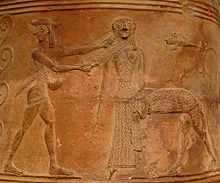Talaria

Talaria (Latin: talaria, Ancient Greek: πτηνοπέδιλος; πτερόεντα πέδαλα) are winged sandals, a symbol of the Greek messenger god Hermes (Roman equivalent Mercury). They were said to be made by the god Hephaestus of imperishable gold and they flew the god as swift as any bird. The name is from the Latin talaria, neuter plural of talaris, "of the ankle".
Appearances
The talaria are mentioned in Homer, who describes them as ἀμβρόσια χρύσεια / ambrósia khrýseia, ("immortal/divine and of gold").[2] However, he does not mention the wings. Those are first mentioned in the Shield of Heracles, which speaks of Ancient Greek: πτερόεντα πέδιλα / pteróenta pédila, literally "winged sandals."[3] Later authors repeat this characteristic, for instance in the Orphic Hymns XXVIII (to Hermes).[4]
In the story of Perseus, he wears them to help him slay Medusa.[5] According to Aeschylus, Hermes gives them to Perseus directly,[6] In a better-attested version, Perseus must retrieve them from the Graeae, along with the cap of invisibility and the kibisis (sack).[7] However, Perseus sees poorly because Hermes does not have his own sandals, nor Hades his own helmet.[8]
In popular culture
In Rick Riordan's fantasy-adventure novel The Lightning Thief, the Talaria is called Maia and are used by Grover Underwood.
See also
- EADS Talarion an unmanned air vehicle named after Talaria.
Notes
- ↑ Gantz, 541.
- ↑ Homer, Odyssey, V, 44.
- ↑ Pseudo-Hesiod, Shield of Heracles, 220.
- ↑ I, 583 and II, 730.
- ↑ Gaius Julius Hyginus, Fables (LXIV) and Nonnus, Dionysiaca, (XIV, 270).
- ↑ Aeschylus, The Phorkides, fr. 262 iv, v Radt.
- ↑ Pherecydes of Leros, 3F11 Fragmente der griechischen Historiker, and the Bibliotheca (Pseudo-Apollodorus), II, 4, 2.
- ↑ Gantz, 542.
References
- Timothy Gantz, Mythes de la Grèce archaïque, Belin, 2004, p. 541-543.
External links
 Media related to Talaria at Wikimedia Commons
Media related to Talaria at Wikimedia Commons
